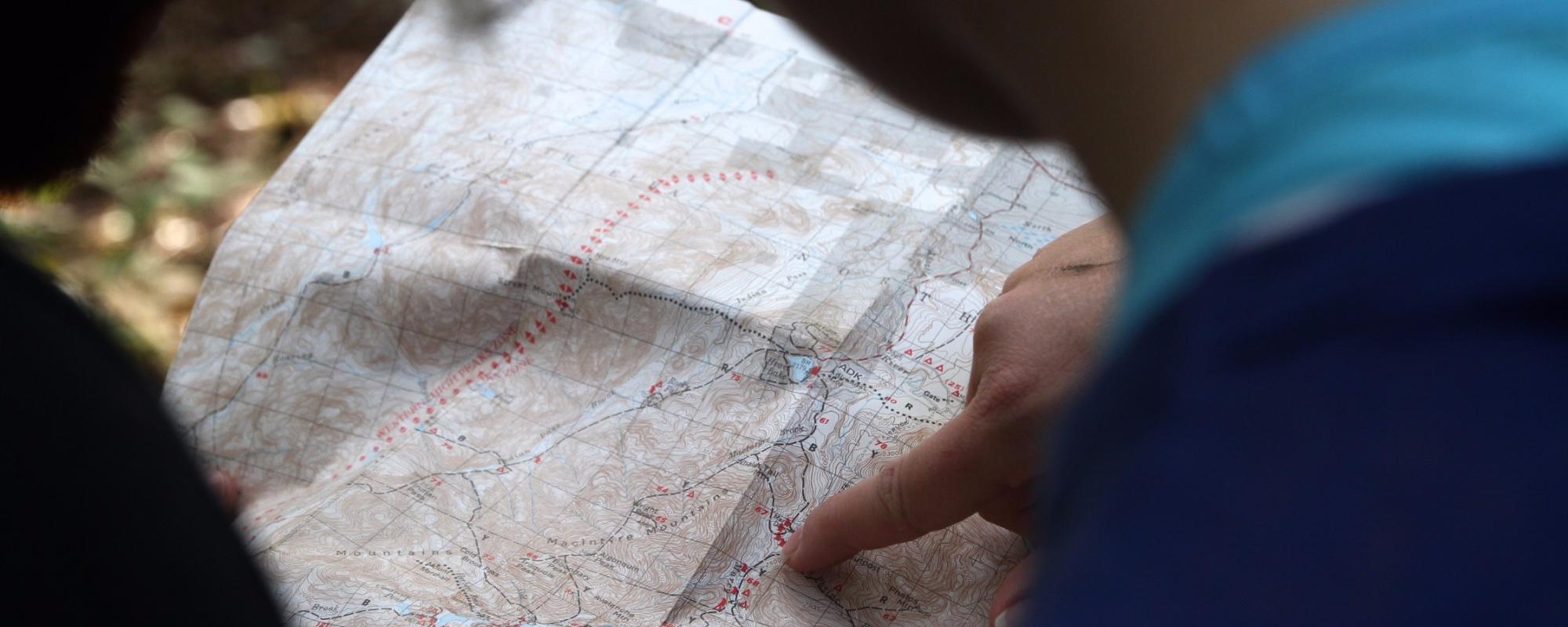The Earth’s Coordinate System (Latitude and Longitude)
The first step in converting the information contained in the real–world onto a ‘piece of paper’ was to devise a system where everything could be uniquely located in the world.
Very early maps (which usually showed small local or regional areas) used a grid technique which relied on simply measuring the distance and direction between points of interest and then plotting these onto the ‘piece of paper’. This method assumed that the Earth was flat.
With the general agreement that the Earth was, in fact, round, a different methodology needed to be developed. The system that has been developed over many centuries is called latitude and longitude.
The location and measurement of latitude and longitude essentially involves complex mathematics (especially geometry) and a series of international agreements ⁄ conventions for recording locations on the surface of the Earth.
Latitude
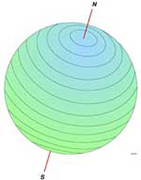
The first convention to be developed was latitude. This is based on long term astronomical observations about how the sun is perceived to move across the surface of the Earth.
These observations also developed the conventions that the sun:
- rises in the east and sets in the west
- is in the south during a European winter and in the north in a European summer.
It was agreed that a line around the centre of the Earth would be called the Equator. This would be numbered as zero degrees (0°) of latitude. From the Equator a series of parallel lines were recognised with the most northern and southern points being called the North Pole and South Pole. These would be numbered as 90 degrees North and South respectively (90°N and 90°S).
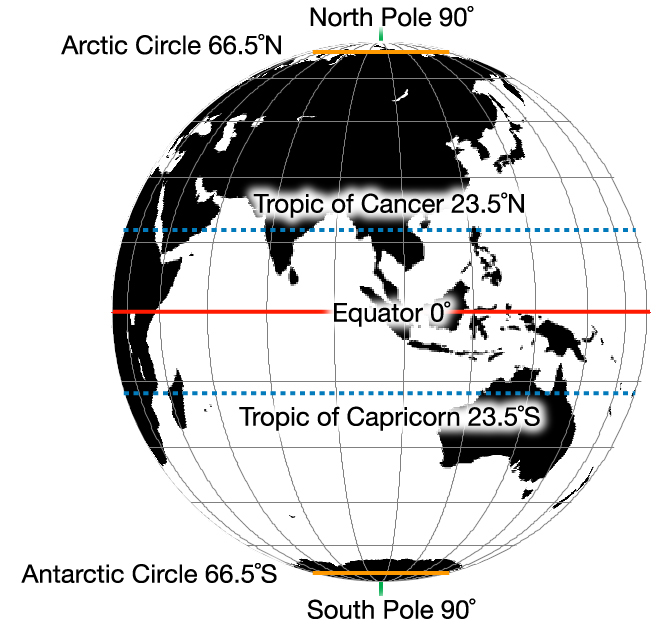
Four significant lines of latitude were also agreed upon. These are:
- 0° - The Equator
- 23.5°N and S - The Tropics (called Cancer in the north and Capricorn in the south)
- between these two, at some time of the year, the sun is directly overhead
- beyond each of these the sun is never directly overhead
- 66.5°N and S - The Polar Circles
- 90°N and S - The Poles
- beyond the Poles and the Polar Circles 24 hours of daylight (midnight sun) is possible in summer and 24 hours without any daylight is possible in winter.
Because lines of latitude are like slices through the Earth they have different lengths. For example:
- the Equator is 40,075 kilometres long
- the Antarctic Circle is 17,662 kilometres long
- the South Pole is 0 kilometres long.
For obvious reasons, lines of latitude are called parallels.
Longitude
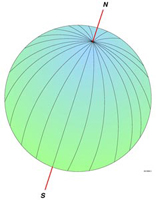 Defining longitude was much more difficult, as it is could not be based on observations of movement of the sun. It was, in part, influenced by the discovery of Magnetic North, but ultimately longitude is mostly based on abstract mathematical / geometric concepts.
Defining longitude was much more difficult, as it is could not be based on observations of movement of the sun. It was, in part, influenced by the discovery of Magnetic North, but ultimately longitude is mostly based on abstract mathematical / geometric concepts.
The convention eventually agreed upon was to have a series of radiating lines which run vertically around the Earth. They connected at both ends – i.e. at the North Pole and the South Pole. As a result of this, a series of ‘slices’ much like slices of an orange are created. These are pointed at their ends and broadest in the middle.
It was agreed that a primary line of longitude should be identified and that this should be zero degrees (0°) of longitude.
For a considerable period of time the issue of which line of longitude was to be the primary line could not be agreed. For obvious religious reasons, early European maps often used Jerusalem as the primary line of longitude. Because of its status as a centre of learning other early map makers, such as Ptolemy, had used Alexandria in Egypt. More commonly though, for patriotic reasons, many countries chose one of their cities. A few European examples are Copenhagen, Madrid, Paris and Saint Petersburg; while in the United States of America Washington and Philadelphia had been chosen.
Eventually, in October 1884, at the International Meridian Conference, it was agreed that the line of longitude that runs through the Royal Observatory, Greenwich in United Kingdom, was to be adopted as the standard primary line of longitude.
Radiating to the east and to the west would be 180° of longitude. These would meet at the opposite side of the Earth and form a joint 180° line of longitude (with 180°E and 180°W being the same line).
Lines of longitude are called meridians.
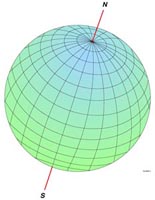 Add the Two Together
Add the Two Together
Combine latitude and longitude together and we have a system to record the location of any feature on the surface of the Earth uniquely.
Explaining Some Jargon – Hemispheres
The creation of the concept of latitude and longitude resulted in the creation of the concept of Earth’s hemispheres. These are:
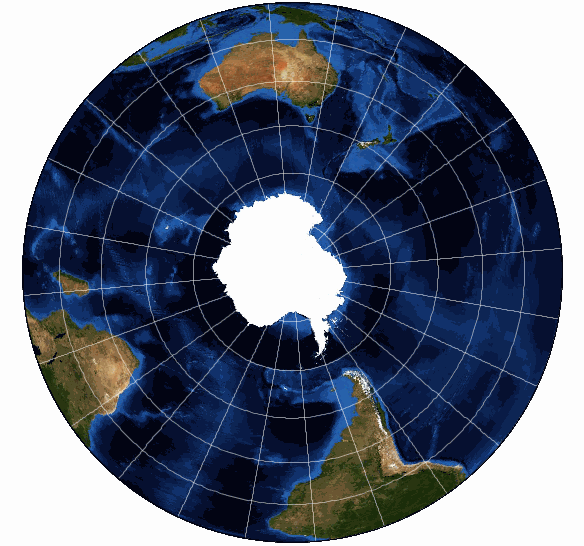

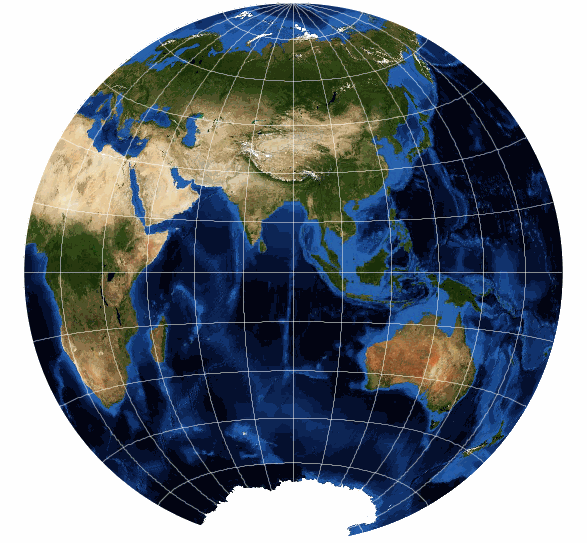
Note with this definition continental Europe is in the Eastern Hemisphere.
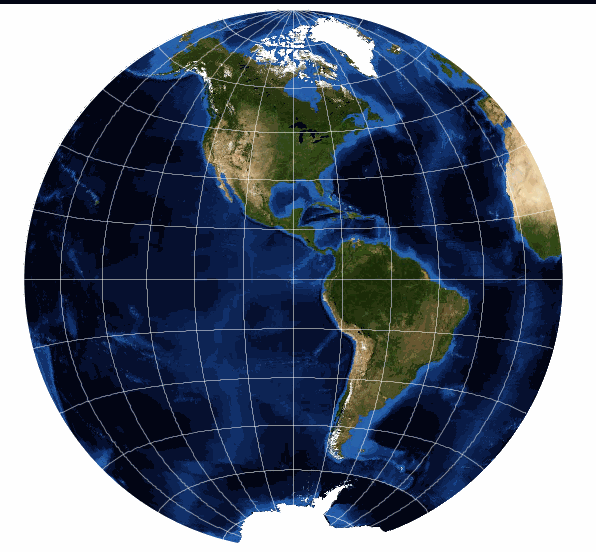
Explaining Some Jargon – North Pole
There are two North Poles:
The first is the Geographic (or True) North Pole:
- It is the point on the Earth which is calculated as the northerly point which is furthest away from the Equator
- It defined as 90°N
- It is located in the middle of the Arctic Ocean
The second is the Magnetic North Pole
- It is the point that a magnetic compass points to.
- It is presently located in Canadian Territorial waters, west of Greenland. It is slowly moving in a north-westerly direction across the Arctic Ocean. It is estimated that it is moving at a speed of about 40 kilometres per year and over the last century the Magnetic Pole has moved a remarkable 1100 kilometres.
- This magnetic attraction and movement is a result of the magnetic forces within the Earth.
The GisGeography website has a good explanation on how the Earth's magnetic field works and information about the North Magnetic Pole: http://gisgeography.com/magnetic-north-vs-geographic-true-pole/ .
There is also further information available at https://www.dlsweb.rmit.edu.au/toolbox/splash/toolbox_11_04/uoc5/html/p1basic.htm
Finally, there are also two South Poles – Geographic and Magnetic. The Magnetic South Pole is magnetic, but this is very weak and hard to identify even if you are near it, as a result magnetic compasses rarely point to the South Magnetic Pole. Read more about the South Poles on the Australian Antarctic Division's website http://www.antarctica.gov.au/about-antarctica/fact-files/geography/poles-and-directions
Explaining Some Jargon – Great Circles
Any circular line which runs around the Earth at its fattest point is called a Great Circle. This circle has to be centred over the centre of the Earth. Note the following:
- All Lines of Longitude ‘run through both Poles’ and each is therefore half of a Great Circle
- For Lines of Latitude only the Equator is a Great Circle
- Other Great Circles can be positioned at any angle over the Earth – the only limit on how it can be placed is that they must have the centre of the Earth as their centre
Why the fuss about Great Circles? The answer is that for any two points on the surface of the Earth, the shortest distance between those points is always along a Great Circle. When you look at a map a Great Circle is usually not a straight line. This is because of distortions that are created when the surface of the Earth is projected onto a ‘flat piece of paper’.
Explaining Some Jargon – Time Zones
Until the 1890’s time keeping was a local affair. Most people regulated their day by the movement of the Sun – sunrise, noon/midday and sunset. Only the rich could afford clocks and in many places the town hall clocks or the church bells were the only source of official/consistent time.
In the late-1800’s with the development of long distance railways a problem emerged – they needed to run to a schedule and inconsistent times caused significant problems. In 1878, Canadian Sir Sanford Fleming, proposed a system of worldwide time zones based on lines of longitude. Using zones of longitude which were 15° wide he was able to divide the Earth into 24 time zones (one for each hour of the day).
The 0° line of longitude (Greenwich Meridian) was chosen as the start point of the system and the 180° line of longitude was the end point. To the east time progressively became later in a day and to the west time progressively became earlier in a day. This resulted in the creation of an interesting phenomenon at the 180° line of longitude – the International Date Line.
By the mid-1900’s this had become an agreed international system, although some countries, in order to minimise time variations, have opted to choose a particular time for their whole country – regardless of where the longitudinal lines run.
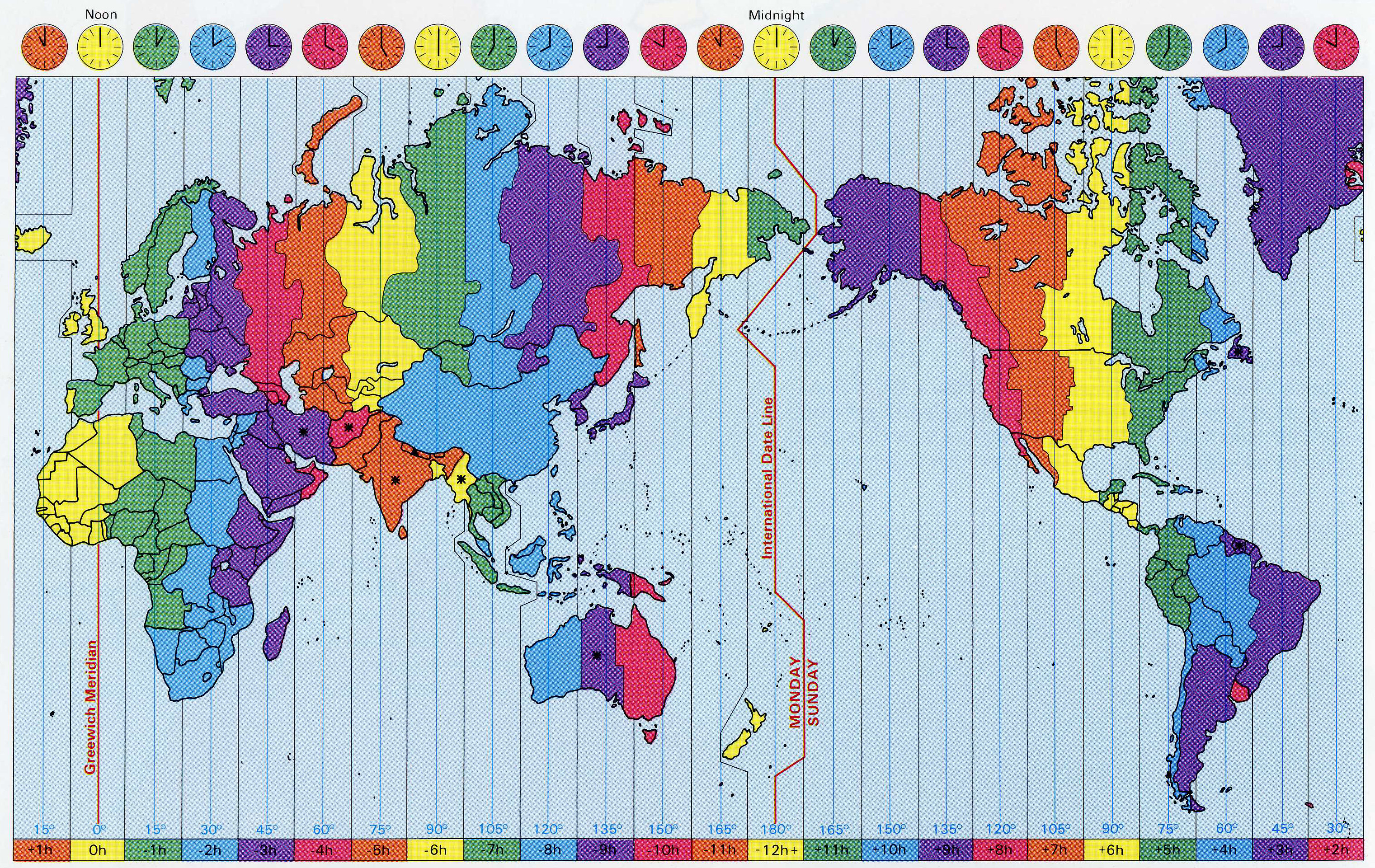
Things to note on this map include:
- How time zones in individual countries match their International or State Borders – eg:
- China, which crosses five time zones, has chosen to use only one time
- Australia and United States of America cross several time zones and they have chosen to use these times – but these are matched to State/Territory borders
- France and Spain, which are in the same time zone as the United Kingdom, have opted to use the neighbouring time zone – the same as the other countries in continental Europe
- The International Date Line does not totally follow the 180° line of longitude – rather it zigs and zags around the borders of various countries.
Further Reading
- About.com – Geography
- http://geography.about.com/od/locateplacesworldwide/
- From Stargazer to Starships – Latitude and Longitude
- http://www.phy6.org/stargaze/Slatlong.htm
- Natural Resources Canada – Geomagnetism
- http://www.geomag.nrcan.gc.ca/index-en.php
